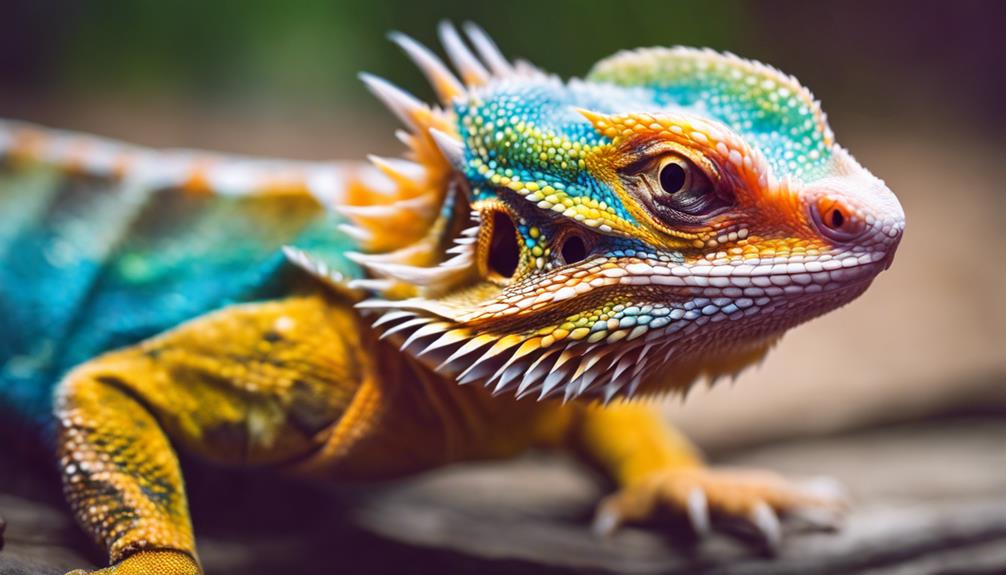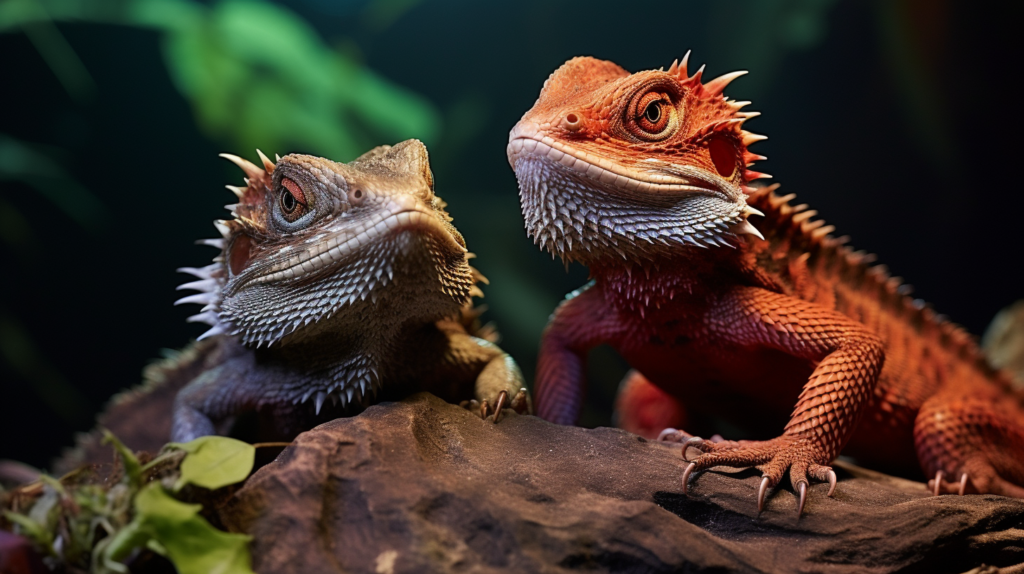When you observe the mesmerizing appearance of a hypo translucent bearded dragon, you may wonder about the secrets hidden within its unique features.
The striking blend of colors and patterns on its scales hint at a deeper complexity that sets this dragon apart from its counterparts.
As you explore the physical characteristics, genetic traits, and behavior of this intriguing reptile, you will uncover a world of wonder that goes beyond the surface.
Discover what truly makes the hypo translucent bearded dragon a fascinating creature worth further investigation.
The hypo translucent bearded dragon is unique due to its vibrant colors and glass-like appearance, which sets it apart from other bearded dragon morphs. Its smooth and slightly shiny skin texture aids in heat retention and camouflage in their natural habitats, making it a fascinating creature worth further investigation.
Physical Characteristics
The Hypo Translucent Bearded Dragon exhibits a unique combination of physical characteristics that set it apart from other bearded dragon morphs. When considering size variation, these dragons typically range from 18 to 24 inches in length, with males generally being larger than females. This size difference is noticeable even from a young age, making it a useful trait for determining gender in juveniles.
In terms of skin texture, the Hypo Translucent Bearded Dragon showcases a smooth and slightly shiny appearance. Their scales are well-defined and have a sleek feel to the touch, differing from the rougher textures seen in other morphs. This distinct skin texture aids in heat retention and camouflage in their natural habitats.
Understanding these physical attributes is crucial for properly caring for these unique creatures. By recognizing their size variation and distinctive skin texture, you can provide the best environment and diet to ensure the well-being of your Hypo Translucent Bearded Dragon.
Coloration and Patterns
With a varied palette of hues and intricate patterns, the coloration of the Hypo Translucent Bearded Dragon is a captivating aspect worth exploring. These dragons exhibit an array of colors ranging from vibrant oranges and yellows to subtle greens and browns. The hypo morph variations, resulting from selective breeding, can intensify or lighten these colors, creating stunning visual effects. The translucent trait adds another dimension, giving the scales an almost glass-like appearance that enhances the overall coloration.
In terms of patterns, Hypo Translucent Bearded Dragons often display intricate markings that can vary from individual to individual. Some may have bold stripes running along their bodies, while others may showcase intricate patterns resembling waves or circles. These patterns can be influenced by genetics as well as environmental factors such as diet and habitat. Providing a balanced diet rich in calcium and maintaining an appropriate habitat with proper lighting and temperature levels can help enhance the coloration and patterns of these fascinating creatures.
Genetic Traits
Exploring the genetic inheritance of the Hypo Translucent Bearded Dragon reveals a complex interplay of traits that contribute to its unique appearance and characteristics. Through selective breeding projects, breeders aim to enhance specific features while minimizing others. Genetic mutations play a crucial role in the breeding potential of these dragons, offering opportunities for new variations to emerge.
In breeding projects, breeders carefully select individuals with desired traits to produce offspring with a particular appearance. By understanding the genetic makeup of the Hypo Translucent Bearded Dragon, breeders can predict the outcome of specific pairings and work towards refining the breed standard.
Genetic mutations can lead to unexpected variations in coloration, patterns, and even physical characteristics. These mutations provide breeders with a diverse range of options to explore, expanding the possibilities within the breed.
Behavior and Temperament
Behavior and Temperament in the Hypo Translucent Bearded Dragon exhibit a fascinating blend of instinctual responses and learned behaviors that shape their interactions with their environment and caregivers. These dragons are known for their curious and sociable nature, making them popular pets among reptile enthusiasts. When it comes to handling techniques and socialization, it’s essential to approach them calmly and confidently to build trust. Regular and gentle interactions help them feel comfortable and secure in your presence. Training methods offer bonding opportunities, allowing you to establish a strong connection with your dragon. Through positive reinforcement and consistency, you can teach them basic commands and encourage desired behaviors. Bearded dragons are intelligent creatures that respond well to proper training and a nurturing environment.
—
| Handling Techniques | Training Methods |
|---|---|
| Approach calmly and confidently | Use positive reinforcement |
| Regular gentle interactions | Be consistent in training |
| Build trust through handling | Teach basic commands |
| Ensure comfort and security | Encourage desired behaviors |
| Supervise children during handling | Create a nurturing environment |
Care and Husbandry
Carefully monitor the temperature and humidity levels within the habitat of your Hypo Translucent Bearded Dragon to ensure optimal living conditions. Maintaining a suitable environment is crucial for the health and well-being of your pet.
Feeding Habits: Provide a diet consisting mainly of insects such as crickets, dubia roaches, and mealworms. Supplement with leafy greens and vegetables for a balanced nutrition.
Environmental Requirements: Ensure the enclosure has a basking spot of around 95-105°F (35-40°C) and a cooler side around 75-85°F (24-29°C). UVB lighting is essential for calcium absorption.
Common Health Issues: Watch for signs of metabolic bone disease, respiratory infections, and parasites. Regular veterinary check-ups are recommended.
Handling Techniques: Approach your dragon calmly and support their body properly when handling to prevent stress or injuries. Avoid grabbing the tail, as they can drop it as a defense mechanism.
Proper care and attention to these details will help your Hypo Translucent Bearded Dragon thrive in captivity.
Frequently Asked Questions
Are Hypo Translucent Bearded Dragons More Prone to Certain Health Issues Compared to Other Bearded Dragon Morphs?
Hypo translucent bearded dragons can have genetic predispositions to certain health concerns like eye issues or neurological problems. However, proper care, including ideal environmental factors and attentive husbandry, can help mitigate these risks.
Do Hypo Translucent Bearded Dragons Require Any Special Lighting or Heating Requirements?
To ensure your hypo translucent bearded dragon thrives, focus on creating a habitat setup with proper temperature regulation and UVB lighting. These dragons need specific heating requirements and supplements to maintain their health and well-being.
How Do Hypo Translucent Bearded Dragons Behave in Social Settings Compared to Other Bearded Dragon Morphs?
In social settings, hypo translucent bearded dragons display unique behavioral patterns. They often exhibit more territorial tendencies compared to other morphs, using specific communication signals to establish dominance and boundaries. Understanding these cues is crucial for harmonious interactions.
Can Hypo Translucent Bearded Dragons Be Bred With Other Morphs to Produce Unique Offspring?
When breeding hypo translucent bearded dragons with other morphs, you can create a diverse range of color variations and patterns. Understanding the genetics involved is crucial for producing unique offspring with distinct physical characteristics.
Are There Any Specific Dietary Considerations for Hypo Translucent Bearded Dragons That Differ From Other Morphs?
Feeding a hypo translucent bearded dragon requires attention to detail. Ensure varied diet for optimal growth rates. Watch their digestive health with proper supplements. Vitamin-rich foods are vital for their well-being.
Conclusion
In conclusion, the hypo translucent bearded dragon presents a rare and visually stunning appearance due to its unique combination of physical characteristics, coloration, and genetic traits.
Their behavior and temperament also add to their appeal, making them a fascinating and captivating species to care for.
With proper husbandry and attention to their specific needs, these dragons can thrive and bring joy to any reptile enthusiast’s collection.


